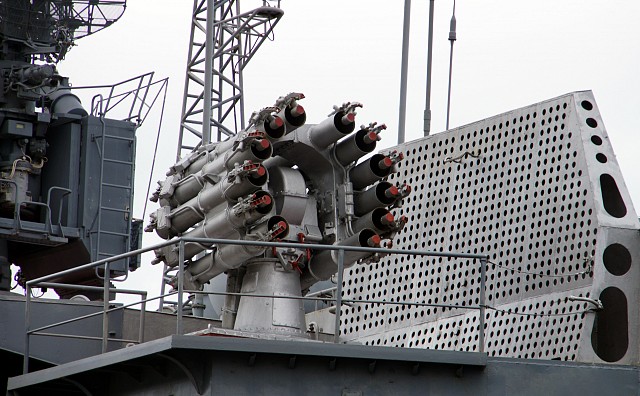SOURCE: AFI


The RBU-6000 Smerch-2 is a naval anti-submarine warfare (ASW) rocket depth charge system of Soviet origin, developed in the 1950s. Despite its age, it continues to serve as a key component in the Indian Navy’s ASW arsenal, raising questions about the balance between modernization and reliance on older yet proven technologies.
The RBU-6000 is known for its distinctive 12-tube launcher mounted on a pedestal, a remote-controlled system that is fed from a below-deck magazine via a hoist system. This launcher, unlike its predecessors, has the advantage of being highly maneuverable. It can rotate and elevate, with stabilization to account for the ship’s pitch and roll, allowing for more precise targeting without needing to steer the entire ship—a significant improvement over earlier fixed-mount systems. The launcher is controlled by a fire control system integrated with sonar input, which enhances its effectiveness against submarines and underwater threats.
One of the system’s primary munitions is the RGB-60, a rocket-powered depth charge armed with a 25 kg high-explosive warhead. Initially equipped with an impact fuse, the system was upgraded in the 1960s to include a proximity fuse, which triggers nearby depth charges to enhance the concussive force of the explosion. This feature greatly improves the RBU-6000’s capability to create a wider area of destruction, essential when targeting fast-moving or evasive submarines.
In the face of modern submarine technology and evolving threats, the RBU-6000 received an upgrade in the form of the RPK-8 system. This newer version uses the 90R smart, self-guiding depth charge, which is equipped with a shaped charge warhead capable of penetrating double-hull submarines—a design often found in advanced, modern subs. Unlike the RGB-60, the 90R can also be deployed in a torpedo defense role, giving the system added versatility in modern naval warfare.
The RBU-6000 remains in widespread use across the Indian Navy, which has long relied on Soviet and Russian-made military hardware. Its continued deployment reflects the system’s reliability and the Indian Navy’s need for a proven, cost-effective ASW solution. The RBU-6000 offers simplicity and effectiveness in targeting submerged threats, making it an attractive option for ASW missions, especially in shallow waters where submarines are more likely to be detected and engaged.
Despite its proven track record, the RBU-6000’s continued use is increasingly being questioned. Critics argue that it is an outdated system, especially when compared to more modern ASW technologies such as advanced torpedoes and sonar-guided munitions. While the RPK-8 upgrade adds some degree of modernization, the core system remains a product of 1950s-era engineering. Submarines today are far more advanced, utilizing stealth technologies, quieter propulsion systems, and electronic countermeasures that may outmatch the capabilities of an unguided, rocket-powered depth charge system like the RBU-6000.
For the Indian Navy, the RBU-6000 presents a dilemma: Is it worth continuing to rely on an aging system that has been a cornerstone of naval ASW for decades, or is it time to fully transition to newer, more sophisticated alternatives? While the RBU-6000 has been effective in past engagements, future naval warfare may require more advanced solutions capable of addressing both conventional and emerging underwater threats.